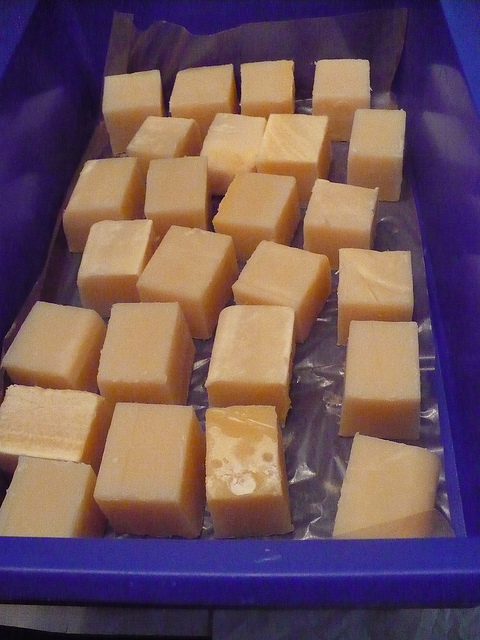Lye is an essential ingredient in soap making but it can be quite dangerous. Photo courtesy of Flickr user maoquai
In Lye Soap Making Sodium hydroxide (NaOH) or potassium hydroxide (KOH), commonly known as lye, are essential ingredients for making soap.
However, lye in all its forms can be quite dangerous, and there are certain precautions which must be taken when working with lye.
Lye is very dangerous if spilled. It is a corrosive material, and can burn skin, or any other surface it comes into contact with.
Use protective equipment and clothing, to prevent skin burning or irritation from a lye spill.
Long pants, a long sleeved shirt, latex or dishwashing gloves, safety goggles, a rubber apron, socks and shoes should all be worn when working with lye.
Be sure to keep the lye away from children and pets – it can be fatal if swallowed.
Work in a well ventilated area, as lye releases toxic fumes when mixed with water; mix outdoors, or wear a protective respiratory mask, if possible.
Vinegar can help to neutralize the lye mixture if it spills, so keep a bottle close at hand while working with lye.
If the lye spills on any surface – skin, furniture, etc. – wash the affected area with vinegar, then soap and water, and rinse it clean.
Lye has deliquescent properties, meaning that it has a tendency to melt or dissolve when it comes into contact with open air;
it is also hygroscopic, meaning that it will absorb moisture from the air, and will form lumps in the powder. Either of these tendencies can render the lye unusable if it comes into contact with open air for long, so the container in which it is stored must always be sealed.
Be sure to purchase lye that is labeled for soap-making. There are other lye products that are similarly packaged, such as food-grade lye, or 100% lye drain opener. The food-grade lye is not strong enough to make soap with, and the lye drain opener is, of course, much too harsh, and contains many other chemicals which you would not want on your skin.
There are some materials which should never come into contact with lye. Do not use any container or heating vessel made of aluminum, brass, bronze, chromium, iron, magnesium, zinc, or anything coated with Teflon. If the lye comes into contact with any of these materials, it will react with them to produce hydrogen gas, which is extremely flammable, and explosive.
Also, the lye should never come into contact with sugar; this mixture will produce poisonous carbon monoxide gas.
Materials that are suitable for contact with lye, at room temperature, are: high-density polyethylene (HDPE), polypropylene (PP), polyvinyl chloride (PVC), silicon rubber, stainless steel, glass, and porcelain. Stainless steel is the best material for heating vessels, as it can withstand elevated temperatures. Plastics may soften at higher temperatures, so unless the plastic has already been tested, glass or stainless steel are the best materials for mixing containers.
Because lye is a corrosive material, any amount of it that you order or purchase will most likely come with a material safety data sheet, or MSDS. This sheet will list:
•Manufacturer or vendor information
•Chemical composition
•Hazards and potential health effects
•First aid measures
•Fire fighting measures
•Spill measures
•Handling and storage
•Exposure and protection
•Physical and chemical properties
•Stability and reactivity
•Toxicological information
•Environmental information
•Disposal considerations
•Transportation information
•Regulatory information
Before handling the lye, be sure to review the MSDS, so that you know how to handle it, what precautions to take, and what to do in case of an emergency.
Making soap by hand can be a fun, challenging and rewarding process, and despite the inherent dangers involved with coming into contact with lye, if the proper precautions are taken, accidents and injuries can be easily avoided.
Take the next step
Make sure you download our FREE comprehensive beginners guide, ‘How To Make Soap At Home’, by clicking here.
If you are ready to get serious about soap making, we have a special offer on our Soap Making Ebooks range, with a risk free 60 day money back guarantee! Also available for Kindle, iPhone, iPad, Android and all major Ebook reader platforms.
